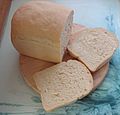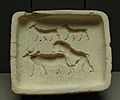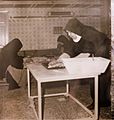Baking facts for kids
Baking is a popular way of cooking food. It usually involves heating food in an oven. Sometimes, baking can also be done using hot ashes or stones. Many delicious foods are made by baking. These include bread, cakes, pastries, pies, cookies, and more. Foods made this way are often called "baked goods".
Baking uses many different ingredients. Common ones are flour, water, and things that make dough rise. These "leavening agents" include baker's yeast, baking soda, and baking powder. Other ingredients are fats (like oils), eggs, milk, and sugars.
All these ingredients are mixed to make a dough or batter. This mixture is then placed in a pan or on a sheet and heated. Leavening agents create gas bubbles. These bubbles get trapped in the dough, making it puff up and become light. Fats help make the dough easier to work with. They also make the final baked food soft and tender. Egg whites can help create a light, airy texture.
You can buy baked goods at a bakery. A person whose job is to make baked goods is called a baker. Baking is not just for sweets. It's also used for foods like baked potatoes, baked apples, and casseroles. Even pasta dishes like lasagna and pretzels are baked.
Contents
History of Baking
Early Baking Methods
Baking has a very long history. The first baking likely happened when early humans used wild grains. They would soak these grains in water, then mix and mash them. This mixture was then poured onto a hot, flat rock. It was roasted over hot embers from a fire. This new way of making bread was much simpler. It meant bread could be made whenever fire was available.
Baking in Ancient Civilizations
Around 2500 BC, people in Egypt were making bread. They might have learned this skill from the Babylonians. The Greeks, around 400 BC, also enjoyed baked goods. They made tarts with patterns and added honey to their food. A popular Greek baked good was "Dispyrus." It was a donut-like bread made from flour and honey. It was shaped like a ring and often eaten warm after being soaked in wine. The first evidence of stone ovens comes from Italy. Here, people made early forms of pizza and pasta.
Baking in the Roman Empire
Baking became very popular in the Roman Empire. By about 300 BC, being a pastry cook was a special job for Romans. These cooks were called pastillarium. Romans loved pastry, especially for big parties. Baking was so important that someone who invented a new pastry could even win an award. Around 1 AD, there were over 300 pastry chefs in Rome.
Baking Spreads Globally
From Rome, the art of baking spread across Europe. Later, it also reached parts of Asia. For a long time, bakers would make goods at home. Then, they would sell them on the streets. In London, chefs sold their baked goods from handcarts. The first café dedicated to baked goods opened in Paris. Baking truly became an art form around the world. Today, many cakes can be mixed quickly. They can be ready from the oven in less than 30 minutes. A basic loaf of bread takes a bit longer. However, it still doesn't need constant attention from the cook.
Images for kids
-
Anders Zorn - Bread baking (1889)
-
A Palestinian woman baking markook bread on a tava or Saj oven in Artas, Bethlehem, Palestine
-
A terracotta baking mould for pastry or bread. It shows goats and a lion attacking a cow. From the early 2nd millennium BC, Royal palace at Mari, Syria.
-
Vincent van Gogh – The Bakery in Noordstraat (1882)
-
Schulze Baking Company Factory, Chicago (1914–15)
-
Bird baked from bread on the March equinox to celebrate spring and the forty martyrs
-
Baking matzot at Kfar Chabad
-
Benedictine Sisters of Caltanissetta producing the crocetta of Caltanissetta
See also
 In Spanish: Horneado para niños
In Spanish: Horneado para niños













